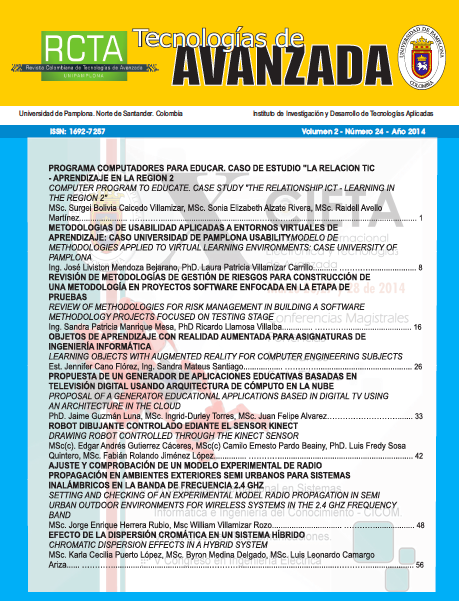Desarrollo de una herramienta en MATLAB para sintonización de controladores PID utilizando algoritmos genéticos basado en técnicas de optimización multiobjetivo
DOI:
https://doi.org/10.24054/rcta.v2i24.1217Palabras clave:
PID, Matlab, sintonizaciónResumen
Este trabajo muestra la versatilidad y eficiencia que presenta el desarrollo de una herramienta en Matlab para sintonización de controladores proporcional, integral y derivativo (PID) utilizando algoritmos genéticos (AG) basado en técnicas de optimización
multiobjetivo (MOP) fundamentado en frentes de pareto; calculando de manera óptima las constantes de ganancia proporcional, ganancia integral y ganancia derivativa (KP, KI, KD) para minimización del error, atenuación del sobrepico máximo y reducción del
tiempo de establecimiento en una planta determinada. Se compara el desempeño que tiene la implementación de algoritmos genéticos en dar soluciones a múltiples objetivos en controladores PID, con la sintonización de controladores PID existente en Sisotool de Matlab, se simularon diferentes sistemas de control de lazo cerrado conformados por una función de transferencia, su controlador y lazo de realimentación. En estos sistemas se analiza el comportamiento que presentan los controladores al aplicarle un Step a la entrada de la planta.
Descargas
Citas
J. Camilo Castro P. and M. Alejandra Guzmán P., (2013). “Optimización Multi-objetivo de un Controlador PID Aplicando Algoritmos Bioinspirados”, CIIMA, vol. 2, No.20, pp 191-197.
M. Claudia Pinto F., (2006). “Sintonización de controladores PID utilizando algoritmos evolutivos”, Universidad de Pamplona, facultad de Ingenierías y Arquitectura, Pamplona Colombia, mayo.
I. A. Ruge and M. A. Alvis, (2009). “Aplicación de los algoritmos genéticos para el diseño de un controlador PID adaptativo”, Tecnura, Vol. 13, No 23, pp 82-90.
K. Ogata, (1993).“Ingeniería de Control Moderna”, Segunda Edición, Traducido por: B. A. Fabian-Kernel, Ed. Prentice Hall, México.
DiStefano, Stubberud and Williams, (1992). “Retroalimentación y Sistemas de Control”, Segunda Edición, Traducido por: R. Gomez Cruz, Ed. Mc. Graw Hill, Bogotá.
John H. Holland, (1992). “Adaptation in Natural Artificial Systems.” MIT Press, Cambridge, Massachusetts, second edition.
John R. Koza. “Genetic Programming: On the Programming of Computers by Means of Natural Selection.” The MIT Press, Cambridge, Massachusetts, 1992.
A.Wetzel, (1983). “Evaluation of Efectiveness of genetic algorithms in combinational optimization.”, University of Pittsburgh, Pittsburgh (unpublished).
Darrel Whitley, (1989). “The GENITOR Algorithm and Selection Pressure: Why Rank-Based Allocation of Reproductive Trials is Best. In Proceedings of the Third International Conference on Genetic Algorithms”, pages 116–121, San Mateo, California, July, Morgan Kaufmann Publishers.
Gunter Rudolph, (1994). “Convergence analysis of canonical genetic algorithms.” IEEE Transactions on Neural Networks, 5(1):96–101, January.
A. K. De Jong, (1975). “An Analysis of the Behavior of a Class of Genetic Adaptative Systems.” PhD thesis, University of Michigan, Michigan.
Gilbert Syswerda, (1989). “Uniform Crossover in Genetic Algorithms.” In J. David Schaffer, editor, Proceedings of the Third International Conference on Genetic Algorithms, pages 2–9, San Mateo, California, Morgan Kaufmann.
Lawrence Davis, (1991). “Handbook of Genetic Algorithms.” Van Nostrand Reinhold, New York.
Van Rensburg, P.J., Shaw, LS. y Van Wyk J. D, (1998). "Adaptive PID-control using a Genetic Algorithm". 1998 Second International Conference on Knowledge-Based Intelligent Electronic Systems.” Editors, L.C. Jain and R.K. Jain. Adelaide, Australia. 21 - 23 April.
K. Deb et al. (2002), “A fast an elitist Multiobjective Genetic Algorithm: NSGA II”, IEEE Transaction on Evolutionary Computation, Vol. 6, No 2.
G. Toscano P., (2001). "Optimización Multiobjetivo usando un Micro Algoritmo Genético", Universidad Veracruzana – Lania, Septiembre.
A. Osyczka, (1984). Multicreterion Optimization in engineering with FORTRAN programs. Ellis HorwoodLimited.
A.F. Muñoz M., (2005). WSEAS, Advance Control of Applied Artificial Cloning. WSEAS, Transactions On Systems, Vol. 4, Issue 7, July.
A.F. Muñoz M., (2003). Tecnologías de control inteligente: Redes neuronales, algoritmos genéticos y de clonación artificial. Vol 1, No. 1.
Descargas
Publicado
Cómo citar
Número
Sección
Licencia
Derechos de autor 2014 Brayan Rene Acevedo Jaimes, Juan Camilo Fonseca Galindo, Antonio Faustino Muñoz Moner

Esta obra está bajo una licencia internacional Creative Commons Atribución-NoComercial 4.0.















